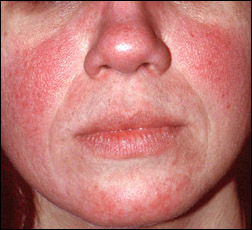Take the Rosacea Quiz
Do you often look red, as if you have been in the sun?
Do you have red bumps (pimples) or blemishes on your cheeks, forehead, nose, or chin?
Do you see small red blood vessels on your cheeks, nose or chin?
Do you look ‘flushed’ after a hot shower, exercise, eating spicy foods, a glass of red wine, hot coffee or tea?
Do your eyes appear irritated or bloodshot even when you are well rested?
If you answered yes to these questions, it is likely that you suffer from Rosacea.
What is Rosacea?

Rosacea is a chronic relapsing and remitting condition that manifests as facial redness, sun sensitivity, pimples swelling of the skin and eye irritation.
There are 4 subtypes of rosacea:
- Facial redness denoted by flushing and tiny blood vessels
- Bumps and pimples
- Skin thickening – typically involving nose and chin
- Eye irritation – stinging, burning or granular sensation of the eyes.
Social and Emotional Implications
Rosacea affects approximately 16 million men and women between the ages of 30 and 70, many of whom are unaware of their condition. Women are more frequently diagnosed than men and individuals with fair skin are particularly at risk. W.C Fields is perhaps the most famous rosacea icon along with former United States president Bill Clinton and prince Harry of England. Society often associates the facial redness of rosacea with over indulgence of alcohol or embarrassment. Individuals suffering from rosacea may experience lower self-confidence or self-esteem. Seventy-six percent of those polled by the National Rosacea Society reported that the condition lowered their self-confidence and self-esteem. Forty-one percent of those polled indicated that they avoided public contact or cancelled social engagements. Among rosacea patients with severe symptoms, 88 percent said the disorder adversely affected their professional interactions.
What is the cure for Rosacea?
We do not have the cure for rosacea and the precise cause is unknown. However, appropriate medical treatments can control and reverse the signs and symptoms as well as halt the progression of rosacea.
How is Rosacea Treated?
Lifestyle management is one category of treatment strategies for rosacea. The most common triggers of rosacea are sun exposure, hot showers or baths, alcoholic beverages, spicy foods, emotional stress, exercise, hot and humid environments. While these activities may exacerbate the flares of rosacea they are not considered causes of the condition. Avoiding these triggers may help reduce the signs and symptoms of rosacea.
A proper skin care regimen can make all the difference for patients with rosacea. First, when cleaning your facial skin, select facial cleansers rather than soap. Even mild soaps such as Dove bar or liquid soaps may be too harsh for rosacea-prone skin. Second, after cleansing, consider an antioxidant product containing green tea, vitamin C or glycolic acid for additional protection from oxidative damage caused by ultraviolet radiation or environmental pollutants. Finally use a moisturizing sunscreen with a sun protective factor (SPF) of 30 or higher. Sunscreens are a mainstay of therapy as well as prevention in the management of rosacea. Sun exposure is the most important trigger of rosacea. Even passive sun exposure such as running errands may expose you to the inadvertent damaging rays of sun that further exacerbate rosacea.
If symptoms of facial redness or pimples continue to progress despite these interventions, your dermatologist can provide prescription strength topical and/or oral medications that may better control the symptoms and halt progression.
Unfortunately, no cleansers, creams or pills remove blood vessels responsible for the redness of rosacea. Light based procedures such as the pulse-dye laser are the treatments of choice for recalcitrant facial redness unresponsive to traditional medical therapies.

